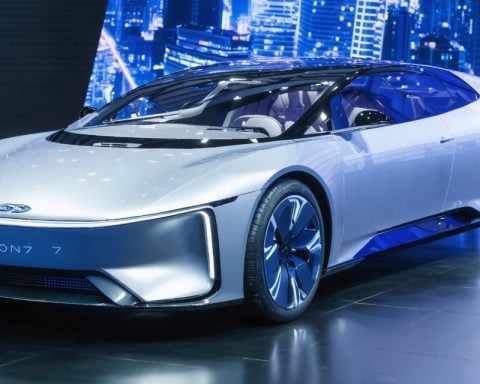Declining Demand for Cybertruck Raises Concerns
Recent insights from Morgan Stanley point to a dip in interest for Tesla’s revolutionary Cybertruck. As the initial excitement wanes, the innovative design might not be enough to keep sales soaring.
In their analysis, Morgan Stanley highlighted slowing sales figures for the Cybertruck, which contributes to revised expectations for Tesla’s growth in 2025. They noted that the anticipated volume increase may only reach 10% instead of the earlier projection of 20%. Factors such as evolving market dynamics and competitive pressures from both the electric vehicle (EV) sector and China are influencing these projections.
Despite having ranked as the fifth best-selling EV in the U.S. last year, the Cybertruck moved close to 39,000 units—a modest figure compared to its competitors. It notably outperformed the Ford F-150 Lightning, which is priced significantly lower.
Future Pricing Strategies
With demand possibly cooling, Tesla may need to consider multiple pricing strategies in 2025. A direct price reduction could be on the table, although this is uncommon. Other potential actions include offering financing incentives, discounts on inventory, or introducing enticing lease options. Furthermore, there’s speculation regarding the reintroduction of a more affordable Rear-Wheel Drive model, which previously had a starting price of $60,990.
As the market landscape evolves, Tesla’s approach to the Cybertruck will be crucial in maintaining its competitiveness.
Implications of Cybertruck’s Declining Demand
The waning excitement for Tesla’s Cybertruck carries significant implications, not just for the company but for the broader landscape of electric vehicles and the global economy. As consumer interest shifts, there emerges a critical question: how will the electric vehicle market adapt to changing dynamics? The Cybertruck, once heralded as a disruptive model, faces increasing competition from traditional automakers and burgeoning EV brands, particularly those based in China. This shift highlights a more competitive atmosphere in a market that was initially dominated by Tesla’s innovation.
Culturally, the Cybertruck’s distinctive aesthetic was not just a reflection of Tesla’s ambition but also served as a symbol of a new era of automotive design. However, its inability to resonate deeply with a broader audience suggests a potential backlash against radical forms in consumer products. This could signal a return to more conventional design principles as consumers seek vehicles that blend traditional aesthetics with advanced technology.
From an environmental standpoint, softer demand for high-profile electric vehicles like the Cybertruck could impede the transition to sustainable transport. The global push towards reducing carbon emissions is crucial; hence, if consumers are deterred by high prices or unconventional designs, the promise of an electric future could stall. Long-term, any misstep in Tesla’s strategic planning could lead to a more fragmented market where affordability and accessibility determine the next phase of electric vehicle growth. Ultimately, how Tesla navigates these challenges will shape not only its future but the EV industry as a whole, steering it towards a sustainable and competitive landscape.
Cybertruck Sales Decline: What Tesla Might Do Next
Understanding the Decline in Cybertruck Demand
Recent analysis from Morgan Stanley has raised concerns regarding the declining demand for Tesla’s much-anticipated Cybertruck. This decline poses significant implications for Tesla’s growth trajectory in the coming years. As the initial excitement around the electric truck begins to dwindle, it is essential to delve deeper into the factors contributing to this slowdown and how Tesla might respond to maintain its market position.
Sales Performance and Market Dynamics
The Cybertruck, despite ranking as the fifth best-selling electric vehicle (EV) in the U.S. last year with approximately 39,000 units sold, is facing increasing competition in the rapidly evolving EV market. While this number outshines some models like the Ford F-150 Lightning, it’s modest compared to what industry analysts had anticipated. Morgan Stanley has revised its projections for Tesla’s expected sales growth for 2025 from an optimistic 20% to a more conservative 10%, largely due to shifting market dynamics and rising competitive pressure, particularly from manufacturers in China.
Pricing Strategies: A Potential Turnaround?
To invigorate demand, Tesla may need to reconsider its pricing strategies. Potential approaches could include:
– Direct Price Reduction: Although it’s uncommon for Tesla to implement pricing cuts, this strategy may be necessary to remain competitive in a softening market.
– Financing Incentives: Offering favorable financing terms can attract budget-conscious buyers who may otherwise hesitate due to higher upfront costs.
– Inventory Discounts: Temporary discounts on existing inventory could help clear out stock and make room for newer models.
– Attractive Lease Options: Introducing appealing lease terms can attract a different customer demographic looking for lower commitment.
– Reintroduction of Base Models: Speculation suggests that Tesla might revive a more affordable Rear-Wheel Drive model, which initially launched at $60,990. This could broaden the appeal of the Cybertruck to a larger audience.
The Competitive Landscape
The electric vehicle market is becoming increasingly saturated with formidable competitors, both domestically and internationally. Rivals such as Ford, Rivian, and various Chinese manufacturers are stepping up their game, offering compelling alternatives that could sway potential Cybertruck buyers.
Future Predictions
As the electric vehicle market matures, the next few years will be critical for Tesla. Analysts predict that if the company adopts innovative marketing and pricing strategies while continuing to enhance its product features, it may still carve out a significant share of the fast-expanding truck segment.
Conclusion: The Road Ahead for Tesla and the Cybertruck
Tesla’s ability to adapt to changing market conditions and consumer preferences will be crucial going forward. While the decline in Cybertruck demand raises valid concerns, strategic adjustments in pricing and product offerings could facilitate a resurgence in enthusiasm for this cutting-edge vehicle.
For more information on Tesla’s latest innovations and market strategies, check out Tesla’s official website.

















